Managing Recruitment, Selection, and Training at Nestle: Project Plan
VerifiedAdded on 2022/12/27
|25
|4949
|69
Project
AI Summary
This project delves into the project management plan for improving recruitment, selection, and training practices at Nestle, a multinational corporation. The project begins by establishing aims and objectives, focusing on how Nestle can enhance its processes to meet international requirements. It then outlines a comprehensive project management plan, covering cost, scope, time, quality, communication, risk, and resources. A work breakdown structure and Gantt chart are included to provide timelines and stages for completion. The research employs both primary and secondary methods, analyzing data to draw meaningful conclusions and provide recommendations. Finally, the project reflects on the value of the undertaking and the student's own learning and performance, offering insights into successful project management in a global business context. The project also provides an in-depth analysis of Nestle's recruitment and selection process, with recommendations for improvement. The project concludes with a reflection on the value of the project and the student's learning. The project includes a detailed analysis of the company's current practices, and proposes strategies for improvement, including the use of technology and training programs. The report also includes a discussion of the risks and challenges involved in implementing these changes, and offers recommendations for mitigating them.
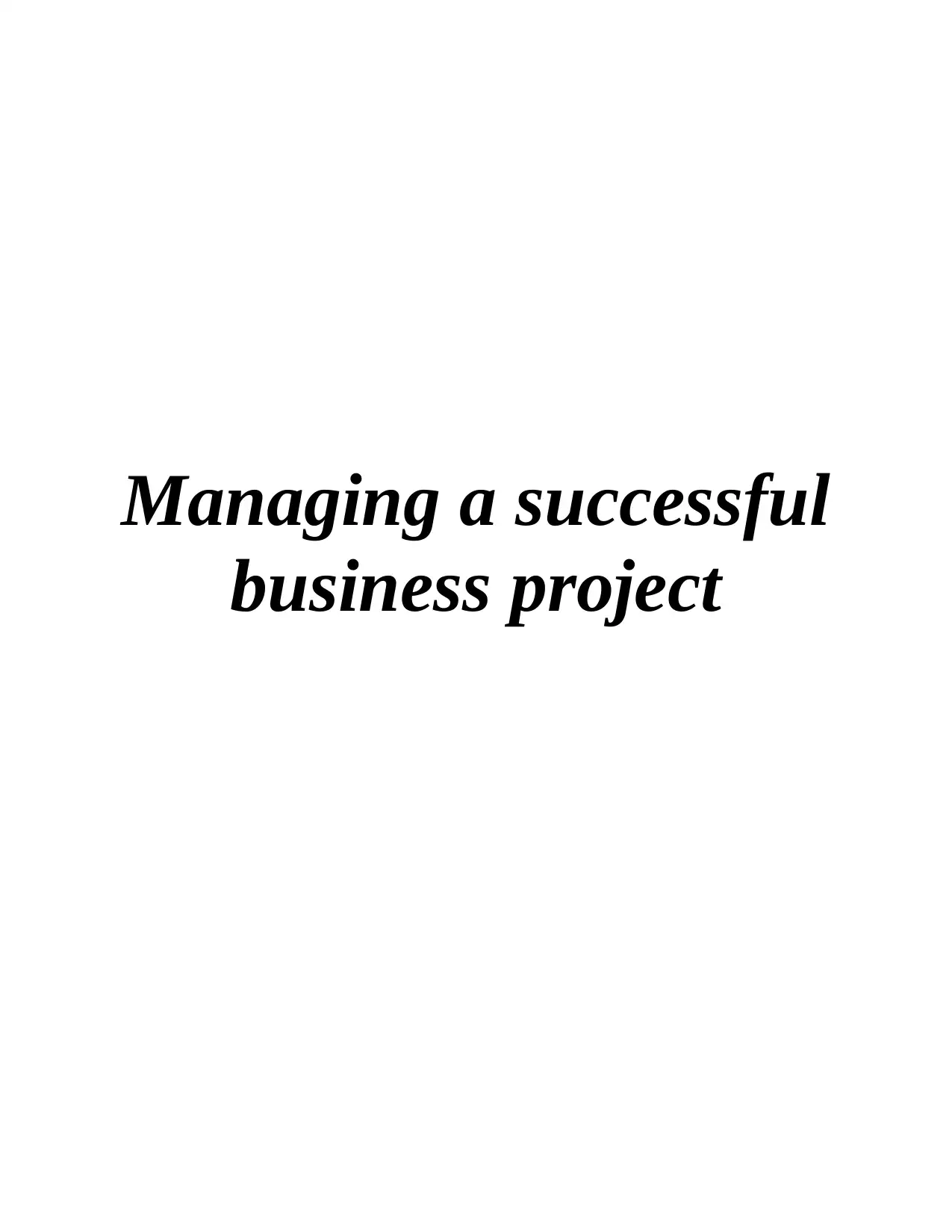
Managing a successful
business project
business project
Paraphrase This Document
Need a fresh take? Get an instant paraphrase of this document with our AI Paraphraser
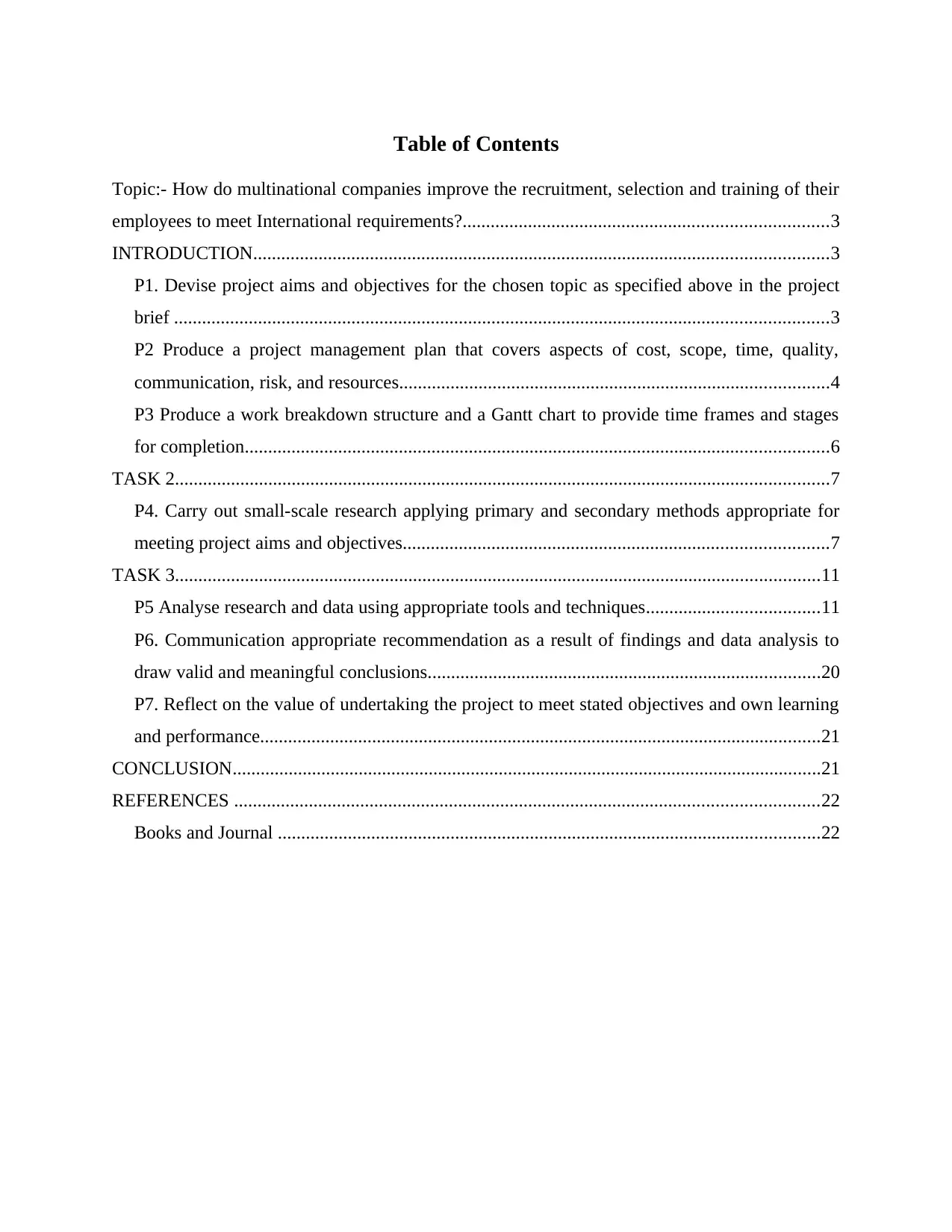
Table of Contents
Topic:- How do multinational companies improve the recruitment, selection and training of their
employees to meet International requirements?..............................................................................3
INTRODUCTION...........................................................................................................................3
P1. Devise project aims and objectives for the chosen topic as specified above in the project
brief ............................................................................................................................................3
P2 Produce a project management plan that covers aspects of cost, scope, time, quality,
communication, risk, and resources............................................................................................4
P3 Produce a work breakdown structure and a Gantt chart to provide time frames and stages
for completion.............................................................................................................................6
TASK 2............................................................................................................................................7
P4. Carry out small-scale research applying primary and secondary methods appropriate for
meeting project aims and objectives...........................................................................................7
TASK 3..........................................................................................................................................11
P5 Analyse research and data using appropriate tools and techniques.....................................11
P6. Communication appropriate recommendation as a result of findings and data analysis to
draw valid and meaningful conclusions....................................................................................20
P7. Reflect on the value of undertaking the project to meet stated objectives and own learning
and performance........................................................................................................................21
CONCLUSION..............................................................................................................................21
REFERENCES .............................................................................................................................22
Books and Journal ....................................................................................................................22
Topic:- How do multinational companies improve the recruitment, selection and training of their
employees to meet International requirements?..............................................................................3
INTRODUCTION...........................................................................................................................3
P1. Devise project aims and objectives for the chosen topic as specified above in the project
brief ............................................................................................................................................3
P2 Produce a project management plan that covers aspects of cost, scope, time, quality,
communication, risk, and resources............................................................................................4
P3 Produce a work breakdown structure and a Gantt chart to provide time frames and stages
for completion.............................................................................................................................6
TASK 2............................................................................................................................................7
P4. Carry out small-scale research applying primary and secondary methods appropriate for
meeting project aims and objectives...........................................................................................7
TASK 3..........................................................................................................................................11
P5 Analyse research and data using appropriate tools and techniques.....................................11
P6. Communication appropriate recommendation as a result of findings and data analysis to
draw valid and meaningful conclusions....................................................................................20
P7. Reflect on the value of undertaking the project to meet stated objectives and own learning
and performance........................................................................................................................21
CONCLUSION..............................................................................................................................21
REFERENCES .............................................................................................................................22
Books and Journal ....................................................................................................................22
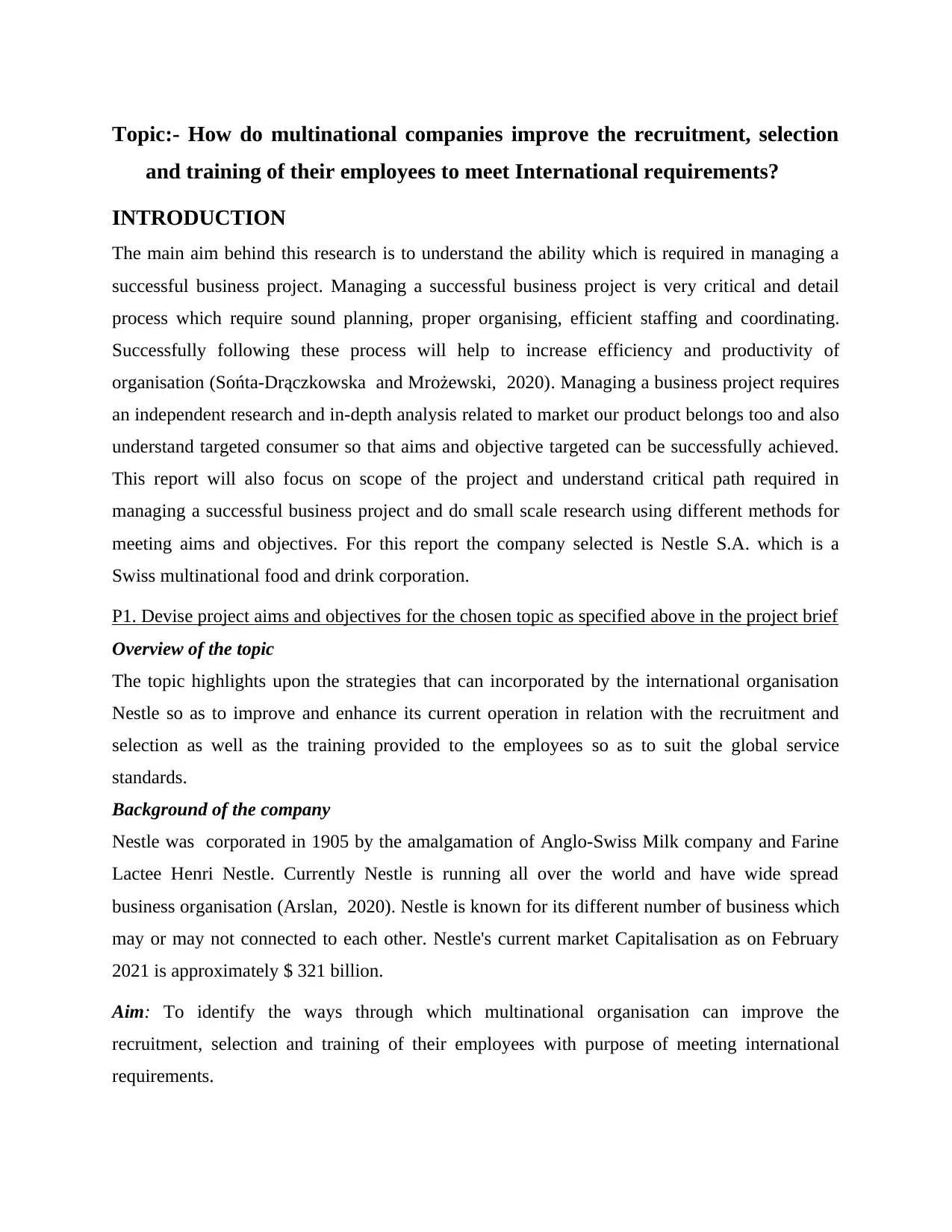
Topic:- How do multinational companies improve the recruitment, selection
and training of their employees to meet International requirements?
INTRODUCTION
The main aim behind this research is to understand the ability which is required in managing a
successful business project. Managing a successful business project is very critical and detail
process which require sound planning, proper organising, efficient staffing and coordinating.
Successfully following these process will help to increase efficiency and productivity of
organisation (Sońta-Drączkowska and Mrożewski, 2020). Managing a business project requires
an independent research and in-depth analysis related to market our product belongs too and also
understand targeted consumer so that aims and objective targeted can be successfully achieved.
This report will also focus on scope of the project and understand critical path required in
managing a successful business project and do small scale research using different methods for
meeting aims and objectives. For this report the company selected is Nestle S.A. which is a
Swiss multinational food and drink corporation.
P1. Devise project aims and objectives for the chosen topic as specified above in the project brief
Overview of the topic
The topic highlights upon the strategies that can incorporated by the international organisation
Nestle so as to improve and enhance its current operation in relation with the recruitment and
selection as well as the training provided to the employees so as to suit the global service
standards.
Background of the company
Nestle was corporated in 1905 by the amalgamation of Anglo-Swiss Milk company and Farine
Lactee Henri Nestle. Currently Nestle is running all over the world and have wide spread
business organisation (Arslan, 2020). Nestle is known for its different number of business which
may or may not connected to each other. Nestle's current market Capitalisation as on February
2021 is approximately $ 321 billion.
Aim: To identify the ways through which multinational organisation can improve the
recruitment, selection and training of their employees with purpose of meeting international
requirements.
and training of their employees to meet International requirements?
INTRODUCTION
The main aim behind this research is to understand the ability which is required in managing a
successful business project. Managing a successful business project is very critical and detail
process which require sound planning, proper organising, efficient staffing and coordinating.
Successfully following these process will help to increase efficiency and productivity of
organisation (Sońta-Drączkowska and Mrożewski, 2020). Managing a business project requires
an independent research and in-depth analysis related to market our product belongs too and also
understand targeted consumer so that aims and objective targeted can be successfully achieved.
This report will also focus on scope of the project and understand critical path required in
managing a successful business project and do small scale research using different methods for
meeting aims and objectives. For this report the company selected is Nestle S.A. which is a
Swiss multinational food and drink corporation.
P1. Devise project aims and objectives for the chosen topic as specified above in the project brief
Overview of the topic
The topic highlights upon the strategies that can incorporated by the international organisation
Nestle so as to improve and enhance its current operation in relation with the recruitment and
selection as well as the training provided to the employees so as to suit the global service
standards.
Background of the company
Nestle was corporated in 1905 by the amalgamation of Anglo-Swiss Milk company and Farine
Lactee Henri Nestle. Currently Nestle is running all over the world and have wide spread
business organisation (Arslan, 2020). Nestle is known for its different number of business which
may or may not connected to each other. Nestle's current market Capitalisation as on February
2021 is approximately $ 321 billion.
Aim: To identify the ways through which multinational organisation can improve the
recruitment, selection and training of their employees with purpose of meeting international
requirements.
⊘ This is a preview!⊘
Do you want full access?
Subscribe today to unlock all pages.

Trusted by 1+ million students worldwide

Objectives:
To understand the concept of recruitment, selection and training.
To determine and evaluate the impact of recruitment selection and training on employee
retention and satisfaction in Nestle. To identify the methods through which Nestle can enhance its recruitment and selection
process so as to meet the global requirements criterion.
Questions
Explain the concept of recruitment, selection and training.
What is the impact of recruitment, selection and training on the employee retention as
well as the satisfaction in nestle ?
Examine the methods that can be utilised by Nestle so as to improvise and enhance its
recruitment and selection process to meet the global requirements ?
P2 Produce a project management plan that covers aspects of cost, scope, time, quality,
communication, risk, and resources.
The development of project management plan can be characterised as a proposed
elaboration and determination of the project abstract (Secundo and Capaldo, 2020). The basic
objective behind the preparation of the former is to provide assistance in facilitating the guidance
for the implementation of the operations as well as the monitoring phase. The respective plan is
formulated to provide the necessary and important information regarding the execution of the
operations determined by the organisation. It involves the resources, objectives scope of work,
milestones, goals and risks etc.
Nestle is one of the leading organisations in its respective industry and is catering its
services at a global platform in order to meet the requirement of the customers from all across
the globe (Rahimian, 2020). The various elements that are need to be taken into consideration in
order to formulate the project management plan of the respective business enterprise are as
follows:-
Cost:
Cost can be termed as the amount invested by the business enterprise so as to run the
business activities of the respective business institution (Winch and Cha, 2020). Cost refers to
To understand the concept of recruitment, selection and training.
To determine and evaluate the impact of recruitment selection and training on employee
retention and satisfaction in Nestle. To identify the methods through which Nestle can enhance its recruitment and selection
process so as to meet the global requirements criterion.
Questions
Explain the concept of recruitment, selection and training.
What is the impact of recruitment, selection and training on the employee retention as
well as the satisfaction in nestle ?
Examine the methods that can be utilised by Nestle so as to improvise and enhance its
recruitment and selection process to meet the global requirements ?
P2 Produce a project management plan that covers aspects of cost, scope, time, quality,
communication, risk, and resources.
The development of project management plan can be characterised as a proposed
elaboration and determination of the project abstract (Secundo and Capaldo, 2020). The basic
objective behind the preparation of the former is to provide assistance in facilitating the guidance
for the implementation of the operations as well as the monitoring phase. The respective plan is
formulated to provide the necessary and important information regarding the execution of the
operations determined by the organisation. It involves the resources, objectives scope of work,
milestones, goals and risks etc.
Nestle is one of the leading organisations in its respective industry and is catering its
services at a global platform in order to meet the requirement of the customers from all across
the globe (Rahimian, 2020). The various elements that are need to be taken into consideration in
order to formulate the project management plan of the respective business enterprise are as
follows:-
Cost:
Cost can be termed as the amount invested by the business enterprise so as to run the
business activities of the respective business institution (Winch and Cha, 2020). Cost refers to
Paraphrase This Document
Need a fresh take? Get an instant paraphrase of this document with our AI Paraphraser
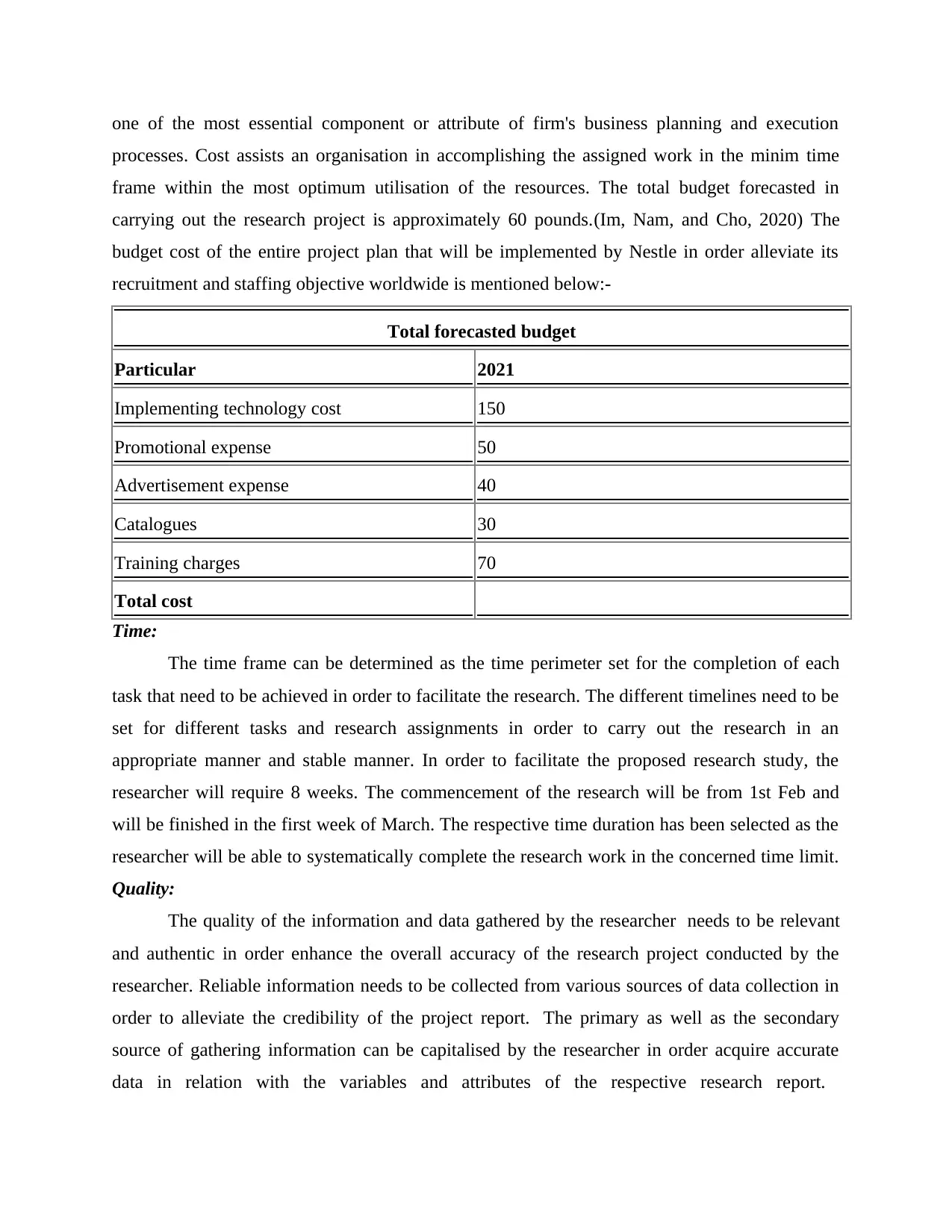
one of the most essential component or attribute of firm's business planning and execution
processes. Cost assists an organisation in accomplishing the assigned work in the minim time
frame within the most optimum utilisation of the resources. The total budget forecasted in
carrying out the research project is approximately 60 pounds.(Im, Nam, and Cho, 2020) The
budget cost of the entire project plan that will be implemented by Nestle in order alleviate its
recruitment and staffing objective worldwide is mentioned below:-
Total forecasted budget
Particular 2021
Implementing technology cost 150
Promotional expense 50
Advertisement expense 40
Catalogues 30
Training charges 70
Total cost
Time:
The time frame can be determined as the time perimeter set for the completion of each
task that need to be achieved in order to facilitate the research. The different timelines need to be
set for different tasks and research assignments in order to carry out the research in an
appropriate manner and stable manner. In order to facilitate the proposed research study, the
researcher will require 8 weeks. The commencement of the research will be from 1st Feb and
will be finished in the first week of March. The respective time duration has been selected as the
researcher will be able to systematically complete the research work in the concerned time limit.
Quality:
The quality of the information and data gathered by the researcher needs to be relevant
and authentic in order enhance the overall accuracy of the research project conducted by the
researcher. Reliable information needs to be collected from various sources of data collection in
order to alleviate the credibility of the project report. The primary as well as the secondary
source of gathering information can be capitalised by the researcher in order acquire accurate
data in relation with the variables and attributes of the respective research report.
processes. Cost assists an organisation in accomplishing the assigned work in the minim time
frame within the most optimum utilisation of the resources. The total budget forecasted in
carrying out the research project is approximately 60 pounds.(Im, Nam, and Cho, 2020) The
budget cost of the entire project plan that will be implemented by Nestle in order alleviate its
recruitment and staffing objective worldwide is mentioned below:-
Total forecasted budget
Particular 2021
Implementing technology cost 150
Promotional expense 50
Advertisement expense 40
Catalogues 30
Training charges 70
Total cost
Time:
The time frame can be determined as the time perimeter set for the completion of each
task that need to be achieved in order to facilitate the research. The different timelines need to be
set for different tasks and research assignments in order to carry out the research in an
appropriate manner and stable manner. In order to facilitate the proposed research study, the
researcher will require 8 weeks. The commencement of the research will be from 1st Feb and
will be finished in the first week of March. The respective time duration has been selected as the
researcher will be able to systematically complete the research work in the concerned time limit.
Quality:
The quality of the information and data gathered by the researcher needs to be relevant
and authentic in order enhance the overall accuracy of the research project conducted by the
researcher. Reliable information needs to be collected from various sources of data collection in
order to alleviate the credibility of the project report. The primary as well as the secondary
source of gathering information can be capitalised by the researcher in order acquire accurate
data in relation with the variables and attributes of the respective research report.
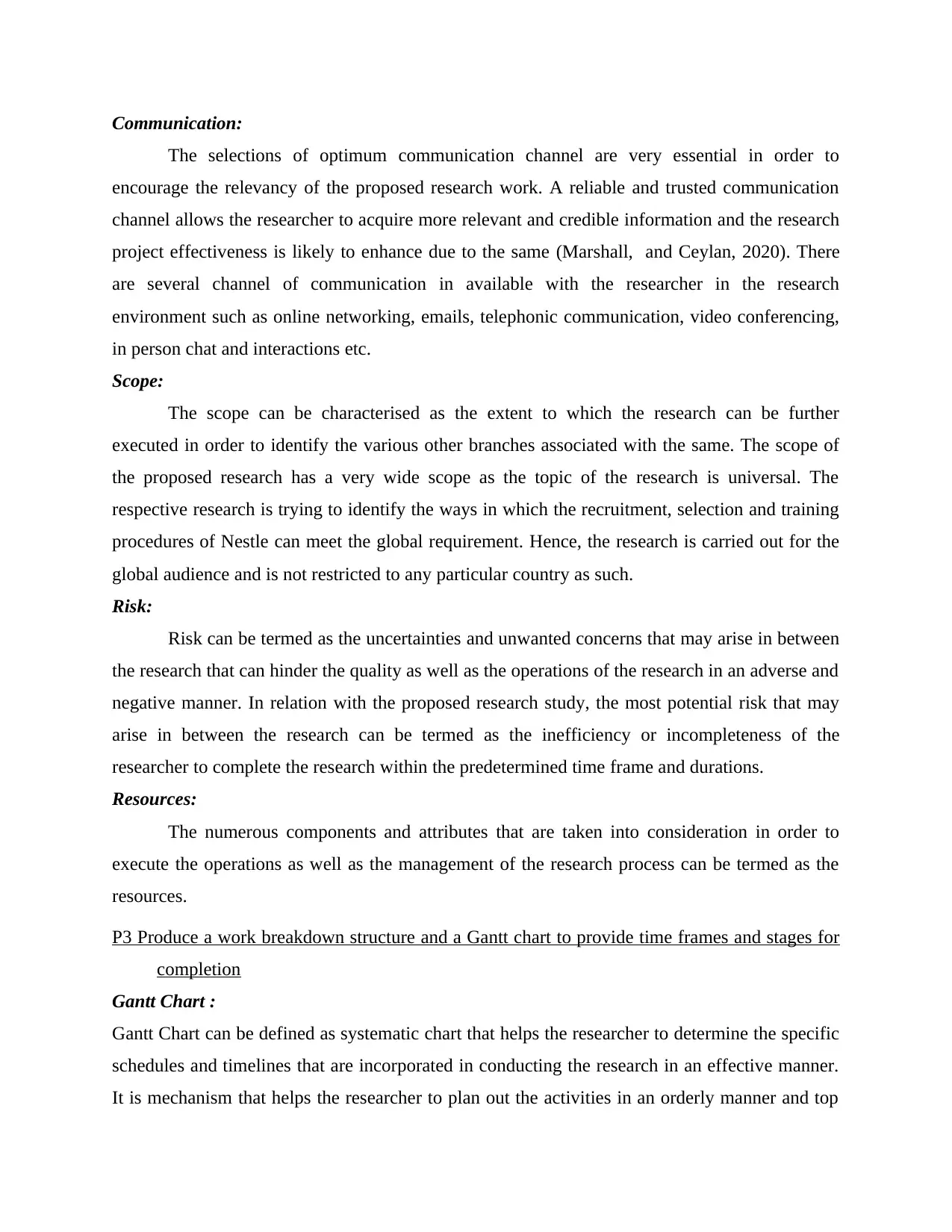
Communication:
The selections of optimum communication channel are very essential in order to
encourage the relevancy of the proposed research work. A reliable and trusted communication
channel allows the researcher to acquire more relevant and credible information and the research
project effectiveness is likely to enhance due to the same (Marshall, and Ceylan, 2020). There
are several channel of communication in available with the researcher in the research
environment such as online networking, emails, telephonic communication, video conferencing,
in person chat and interactions etc.
Scope:
The scope can be characterised as the extent to which the research can be further
executed in order to identify the various other branches associated with the same. The scope of
the proposed research has a very wide scope as the topic of the research is universal. The
respective research is trying to identify the ways in which the recruitment, selection and training
procedures of Nestle can meet the global requirement. Hence, the research is carried out for the
global audience and is not restricted to any particular country as such.
Risk:
Risk can be termed as the uncertainties and unwanted concerns that may arise in between
the research that can hinder the quality as well as the operations of the research in an adverse and
negative manner. In relation with the proposed research study, the most potential risk that may
arise in between the research can be termed as the inefficiency or incompleteness of the
researcher to complete the research within the predetermined time frame and durations.
Resources:
The numerous components and attributes that are taken into consideration in order to
execute the operations as well as the management of the research process can be termed as the
resources.
P3 Produce a work breakdown structure and a Gantt chart to provide time frames and stages for
completion
Gantt Chart :
Gantt Chart can be defined as systematic chart that helps the researcher to determine the specific
schedules and timelines that are incorporated in conducting the research in an effective manner.
It is mechanism that helps the researcher to plan out the activities in an orderly manner and top
The selections of optimum communication channel are very essential in order to
encourage the relevancy of the proposed research work. A reliable and trusted communication
channel allows the researcher to acquire more relevant and credible information and the research
project effectiveness is likely to enhance due to the same (Marshall, and Ceylan, 2020). There
are several channel of communication in available with the researcher in the research
environment such as online networking, emails, telephonic communication, video conferencing,
in person chat and interactions etc.
Scope:
The scope can be characterised as the extent to which the research can be further
executed in order to identify the various other branches associated with the same. The scope of
the proposed research has a very wide scope as the topic of the research is universal. The
respective research is trying to identify the ways in which the recruitment, selection and training
procedures of Nestle can meet the global requirement. Hence, the research is carried out for the
global audience and is not restricted to any particular country as such.
Risk:
Risk can be termed as the uncertainties and unwanted concerns that may arise in between
the research that can hinder the quality as well as the operations of the research in an adverse and
negative manner. In relation with the proposed research study, the most potential risk that may
arise in between the research can be termed as the inefficiency or incompleteness of the
researcher to complete the research within the predetermined time frame and durations.
Resources:
The numerous components and attributes that are taken into consideration in order to
execute the operations as well as the management of the research process can be termed as the
resources.
P3 Produce a work breakdown structure and a Gantt chart to provide time frames and stages for
completion
Gantt Chart :
Gantt Chart can be defined as systematic chart that helps the researcher to determine the specific
schedules and timelines that are incorporated in conducting the research in an effective manner.
It is mechanism that helps the researcher to plan out the activities in an orderly manner and top
⊘ This is a preview!⊘
Do you want full access?
Subscribe today to unlock all pages.

Trusted by 1+ million students worldwide

have a detailed record of the work done on the specific dates and time phrase. This record can act
as an overview of the order in which the research task were accomplished. Gantt chart is
prepared in a horizontal manner which details about the specification of the project report on the
timely basis.
Work Breakdown Structure:
as an overview of the order in which the research task were accomplished. Gantt chart is
prepared in a horizontal manner which details about the specification of the project report on the
timely basis.
Work Breakdown Structure:
Paraphrase This Document
Need a fresh take? Get an instant paraphrase of this document with our AI Paraphraser

The respective tool can be characterised as a management function wherein the facilitation of
work is classified and divided into various categories (Nunes and Abreu, 2020). This is done in
order to process the implementation of the work in an appropriate manner so that the quality of
work can be maintained by the researcher. Breakdown structure is necessary in order to establish
the task objective in a defines manner.
TASK 2
P4. Carry out small-scale research applying primary and secondary methods appropriate for
meeting project aims and objectives.
Research Methodology can be characterised as the processes and the procedures that are
incorporated by the researcher so as to facilitate the gathering of information, processing of the
acquired data, and to assess and examine the same (Michalak, and Rysavy, 2020). Research
Methodology is the amalgamation of all those tools and mechanisms that will undertake by the
researcher in order to process the data and information for the proposed project report. The
researcher may use qualitative method or quantitative method for the data collection. The sources
of data can also classify in two i.e. primary or secondary. The research methodologies adopted
by the researcher in facilitation of the respective research study are as follows:-
Quantitative Research:
The quantitative research can be termed as research process wherein the research i c
ducted in an arithmetical or numerical manner. The respective research in conducted through the
realisation of averages, tests, mathematical patterns. The quantitative research aims at providing
work is classified and divided into various categories (Nunes and Abreu, 2020). This is done in
order to process the implementation of the work in an appropriate manner so that the quality of
work can be maintained by the researcher. Breakdown structure is necessary in order to establish
the task objective in a defines manner.
TASK 2
P4. Carry out small-scale research applying primary and secondary methods appropriate for
meeting project aims and objectives.
Research Methodology can be characterised as the processes and the procedures that are
incorporated by the researcher so as to facilitate the gathering of information, processing of the
acquired data, and to assess and examine the same (Michalak, and Rysavy, 2020). Research
Methodology is the amalgamation of all those tools and mechanisms that will undertake by the
researcher in order to process the data and information for the proposed project report. The
researcher may use qualitative method or quantitative method for the data collection. The sources
of data can also classify in two i.e. primary or secondary. The research methodologies adopted
by the researcher in facilitation of the respective research study are as follows:-
Quantitative Research:
The quantitative research can be termed as research process wherein the research i c
ducted in an arithmetical or numerical manner. The respective research in conducted through the
realisation of averages, tests, mathematical patterns. The quantitative research aims at providing

the percentages and figures of the research report in the numerical orders and terms and rare
most suitable for the research report hat is conducted for a large set of population (Berawi,
2020). The bar graphs and charts are prepared in the quantitative research in order to evaluate
finding of the research in an exact and accurate manner.
Qualitative research:
It can be termed as research that is conducted in accordance with the perspectives of the
individuals prevailing in the research category of the proposed research development. In
qualitative research, the study is conducted in a theoretical manner and the understanding and
concepts are illustrated and elaborated in the same.
For the execution of the propose research study, Quantitative research method has been
adopted as the research outcomes are required be in numerical terms. The deductive approach
has been taken into consideration as it is the most suitable for the facilitation of the particular
research study.
Data Collection: The process of data collection can be described as acquisition of the
relevant information and data that is needed and required for the further facilitation of the
research study (Laryea and Watermeyer, 2020). The data collection is considered to one of the
prominent functions of the research report as it provides the research with the authentic
information that needs to be taken under consideration in order to assist the other research
components. There are two major types of data collection approaches available with researcher
and the concept of the same are mentioned below:-
Primary:
The primary data collection method can be characterised as a tool of data collection
wherein the information is generated through various mediums. It can be termed as the first hand
information that is obtained from the various sources (Suddaby and Jaskiewicz, 2020). The data
provided by primary sources is considered to be the most authentic information. The degree of
quality and relevancy of the primary of the data collection is supremely high. Questionnaires and
surveys can be considered to be one of the best examples of primary form of data collection
method.
Secondary Data:
The secondary data collection method refers to information that is already available in the
research environment and is already been utilised by other researcher as well (Kocsir and Varga,
most suitable for the research report hat is conducted for a large set of population (Berawi,
2020). The bar graphs and charts are prepared in the quantitative research in order to evaluate
finding of the research in an exact and accurate manner.
Qualitative research:
It can be termed as research that is conducted in accordance with the perspectives of the
individuals prevailing in the research category of the proposed research development. In
qualitative research, the study is conducted in a theoretical manner and the understanding and
concepts are illustrated and elaborated in the same.
For the execution of the propose research study, Quantitative research method has been
adopted as the research outcomes are required be in numerical terms. The deductive approach
has been taken into consideration as it is the most suitable for the facilitation of the particular
research study.
Data Collection: The process of data collection can be described as acquisition of the
relevant information and data that is needed and required for the further facilitation of the
research study (Laryea and Watermeyer, 2020). The data collection is considered to one of the
prominent functions of the research report as it provides the research with the authentic
information that needs to be taken under consideration in order to assist the other research
components. There are two major types of data collection approaches available with researcher
and the concept of the same are mentioned below:-
Primary:
The primary data collection method can be characterised as a tool of data collection
wherein the information is generated through various mediums. It can be termed as the first hand
information that is obtained from the various sources (Suddaby and Jaskiewicz, 2020). The data
provided by primary sources is considered to be the most authentic information. The degree of
quality and relevancy of the primary of the data collection is supremely high. Questionnaires and
surveys can be considered to be one of the best examples of primary form of data collection
method.
Secondary Data:
The secondary data collection method refers to information that is already available in the
research environment and is already been utilised by other researcher as well (Kocsir and Varga,
⊘ This is a preview!⊘
Do you want full access?
Subscribe today to unlock all pages.

Trusted by 1+ million students worldwide
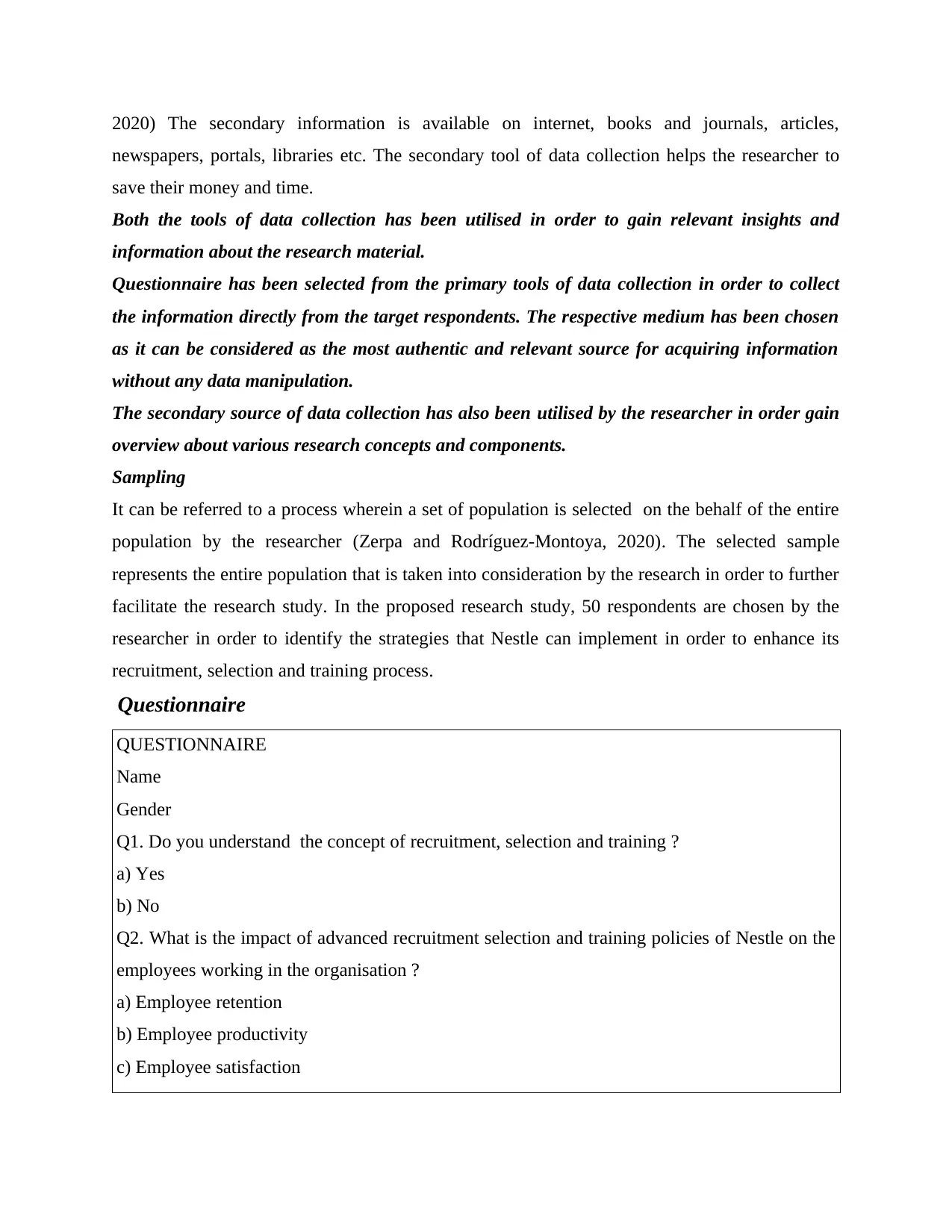
2020) The secondary information is available on internet, books and journals, articles,
newspapers, portals, libraries etc. The secondary tool of data collection helps the researcher to
save their money and time.
Both the tools of data collection has been utilised in order to gain relevant insights and
information about the research material.
Questionnaire has been selected from the primary tools of data collection in order to collect
the information directly from the target respondents. The respective medium has been chosen
as it can be considered as the most authentic and relevant source for acquiring information
without any data manipulation.
The secondary source of data collection has also been utilised by the researcher in order gain
overview about various research concepts and components.
Sampling
It can be referred to a process wherein a set of population is selected on the behalf of the entire
population by the researcher (Zerpa and Rodríguez-Montoya, 2020). The selected sample
represents the entire population that is taken into consideration by the research in order to further
facilitate the research study. In the proposed research study, 50 respondents are chosen by the
researcher in order to identify the strategies that Nestle can implement in order to enhance its
recruitment, selection and training process.
Questionnaire
QUESTIONNAIRE
Name
Gender
Q1. Do you understand the concept of recruitment, selection and training ?
a) Yes
b) No
Q2. What is the impact of advanced recruitment selection and training policies of Nestle on the
employees working in the organisation ?
a) Employee retention
b) Employee productivity
c) Employee satisfaction
newspapers, portals, libraries etc. The secondary tool of data collection helps the researcher to
save their money and time.
Both the tools of data collection has been utilised in order to gain relevant insights and
information about the research material.
Questionnaire has been selected from the primary tools of data collection in order to collect
the information directly from the target respondents. The respective medium has been chosen
as it can be considered as the most authentic and relevant source for acquiring information
without any data manipulation.
The secondary source of data collection has also been utilised by the researcher in order gain
overview about various research concepts and components.
Sampling
It can be referred to a process wherein a set of population is selected on the behalf of the entire
population by the researcher (Zerpa and Rodríguez-Montoya, 2020). The selected sample
represents the entire population that is taken into consideration by the research in order to further
facilitate the research study. In the proposed research study, 50 respondents are chosen by the
researcher in order to identify the strategies that Nestle can implement in order to enhance its
recruitment, selection and training process.
Questionnaire
QUESTIONNAIRE
Name
Gender
Q1. Do you understand the concept of recruitment, selection and training ?
a) Yes
b) No
Q2. What is the impact of advanced recruitment selection and training policies of Nestle on the
employees working in the organisation ?
a) Employee retention
b) Employee productivity
c) Employee satisfaction
Paraphrase This Document
Need a fresh take? Get an instant paraphrase of this document with our AI Paraphraser
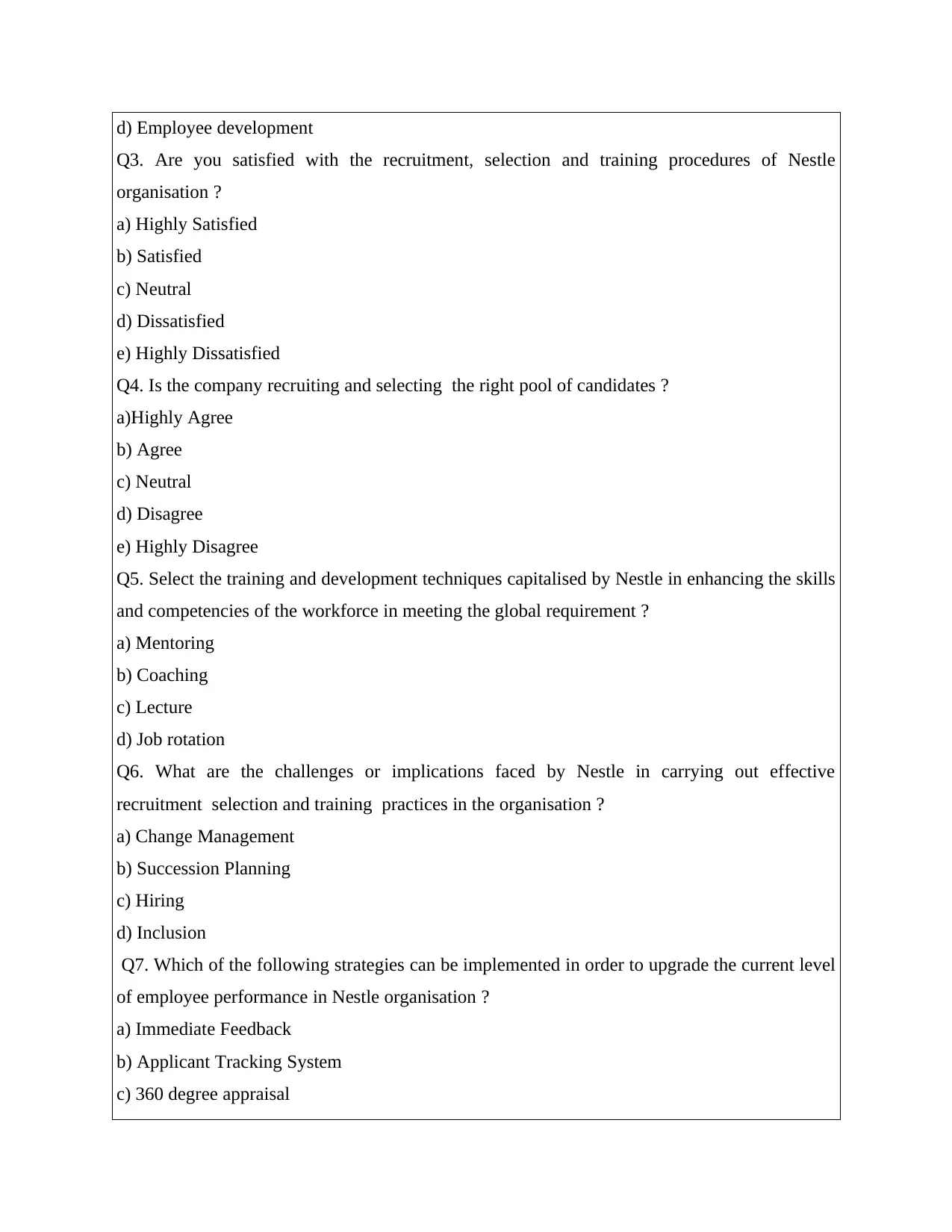
d) Employee development
Q3. Are you satisfied with the recruitment, selection and training procedures of Nestle
organisation ?
a) Highly Satisfied
b) Satisfied
c) Neutral
d) Dissatisfied
e) Highly Dissatisfied
Q4. Is the company recruiting and selecting the right pool of candidates ?
a)Highly Agree
b) Agree
c) Neutral
d) Disagree
e) Highly Disagree
Q5. Select the training and development techniques capitalised by Nestle in enhancing the skills
and competencies of the workforce in meeting the global requirement ?
a) Mentoring
b) Coaching
c) Lecture
d) Job rotation
Q6. What are the challenges or implications faced by Nestle in carrying out effective
recruitment selection and training practices in the organisation ?
a) Change Management
b) Succession Planning
c) Hiring
d) Inclusion
Q7. Which of the following strategies can be implemented in order to upgrade the current level
of employee performance in Nestle organisation ?
a) Immediate Feedback
b) Applicant Tracking System
c) 360 degree appraisal
Q3. Are you satisfied with the recruitment, selection and training procedures of Nestle
organisation ?
a) Highly Satisfied
b) Satisfied
c) Neutral
d) Dissatisfied
e) Highly Dissatisfied
Q4. Is the company recruiting and selecting the right pool of candidates ?
a)Highly Agree
b) Agree
c) Neutral
d) Disagree
e) Highly Disagree
Q5. Select the training and development techniques capitalised by Nestle in enhancing the skills
and competencies of the workforce in meeting the global requirement ?
a) Mentoring
b) Coaching
c) Lecture
d) Job rotation
Q6. What are the challenges or implications faced by Nestle in carrying out effective
recruitment selection and training practices in the organisation ?
a) Change Management
b) Succession Planning
c) Hiring
d) Inclusion
Q7. Which of the following strategies can be implemented in order to upgrade the current level
of employee performance in Nestle organisation ?
a) Immediate Feedback
b) Applicant Tracking System
c) 360 degree appraisal
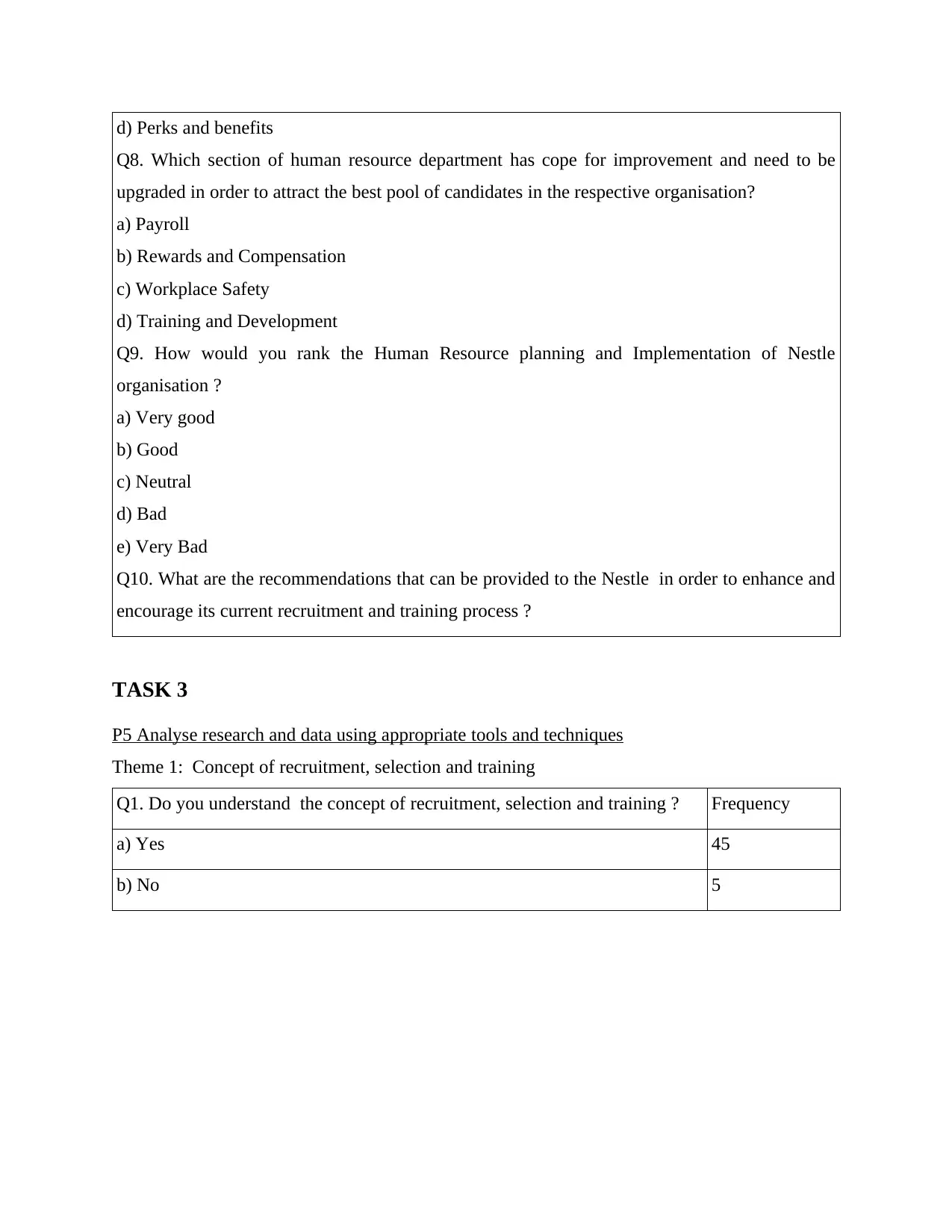
d) Perks and benefits
Q8. Which section of human resource department has cope for improvement and need to be
upgraded in order to attract the best pool of candidates in the respective organisation?
a) Payroll
b) Rewards and Compensation
c) Workplace Safety
d) Training and Development
Q9. How would you rank the Human Resource planning and Implementation of Nestle
organisation ?
a) Very good
b) Good
c) Neutral
d) Bad
e) Very Bad
Q10. What are the recommendations that can be provided to the Nestle in order to enhance and
encourage its current recruitment and training process ?
TASK 3
P5 Analyse research and data using appropriate tools and techniques
Theme 1: Concept of recruitment, selection and training
Q1. Do you understand the concept of recruitment, selection and training ? Frequency
a) Yes 45
b) No 5
Q8. Which section of human resource department has cope for improvement and need to be
upgraded in order to attract the best pool of candidates in the respective organisation?
a) Payroll
b) Rewards and Compensation
c) Workplace Safety
d) Training and Development
Q9. How would you rank the Human Resource planning and Implementation of Nestle
organisation ?
a) Very good
b) Good
c) Neutral
d) Bad
e) Very Bad
Q10. What are the recommendations that can be provided to the Nestle in order to enhance and
encourage its current recruitment and training process ?
TASK 3
P5 Analyse research and data using appropriate tools and techniques
Theme 1: Concept of recruitment, selection and training
Q1. Do you understand the concept of recruitment, selection and training ? Frequency
a) Yes 45
b) No 5
⊘ This is a preview!⊘
Do you want full access?
Subscribe today to unlock all pages.

Trusted by 1+ million students worldwide
1 out of 25
Related Documents
Your All-in-One AI-Powered Toolkit for Academic Success.
+13062052269
info@desklib.com
Available 24*7 on WhatsApp / Email
![[object Object]](/_next/static/media/star-bottom.7253800d.svg)
Unlock your academic potential
Copyright © 2020–2025 A2Z Services. All Rights Reserved. Developed and managed by ZUCOL.




